Non-Patterned Equipment: Tool Carriers: Bags, Pouches, etc.
Stores Ref. F2/FA xxxxxx Pouch, tool, lineman, empty
Stores Ref. F2/FA xxxxxx Pouch, tool, lineman, filled
Stores Ref. F2/FA xxxxxx Pouch, tool, linesmen, empty
Pattern 1914 Leather Infantry Equipment was withdrawn by A.C.I. 9 of 1921; its Para. 2 contained the statement that it “…will be considered as surplus stores and dealt with in R.A.O.C. depots accordingly.” Exactly what was meant by this is not known, but actions could range from straight disposal onto the surplus market, or to be “…reduced to produce…”, which meant items were broken down into elements still useful, which could be re-issued as articles for repair. It also does not imply that disposal was to be immediate, such that stocks of withdrawn equipment might be stored, pending storemen getting round to disposal. If the scale of surplus disposal that has been seen into recent years, items may have survived for years and even decades!
Pouches, tool, line-man are almost identical to Patt. '14 Ammunition pouches, but they are NOT part of I.E., Patt. '14. However, they are clearly derived from Pattern 1914 Ammunition pouches, and are often confused with them (including, in one instance, in a reference book by a well-known author). Line-man tool pouches were added to the stores list by LoC §A2322, dated 20 January 1927.Reference should be made to this for the list of its contents - screwdrivers, pliers, tweezers, scissors, etc. It stated:-
“The above mentioned pouches having been issued as “Pouches, lineman, filled” (Section 29A (N.I.V.) and not previously announced by List of Changes are hereby introduced.”
Nowhere in the LoC is it implied that these were a new store item. They could therefore have been an old store, though usually these are cited as New Designation, or Re-Introduction. The new pouches were actually an old design, possibly even an old store, first withdrawn in 1921, actually being Pouches, ammunition, 60 rounds, Infantry Equipment, Patt. ’14. To prove this, examples dated from 1927 – 1940 are required (Readers, can you help?), as the earliest example noted is 1941 dated.
LoC §C2203, approved 21 February, 1946 finally made this Patt. ’14 relic obsolete. Stocks were to be returned to R.A.O.C. for disposal.
This type of Pouch can be distinguished by the 1-inch strap that hangs below the brace buckle. In the Line-man pouch, the visible chromed strap, in the foreground, shows its flesh side where it's turned over the "V" strap, to secure the buckle. On Patt. '14 Pouches, the arrangement is reversed, the chrome side appearing around the tongue bar. From the Rog Dennis Collection. All photos of this pair of Pouches © Rog Dennis 2012.
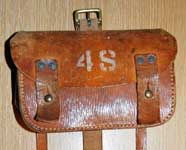
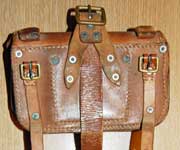 Front and rear views of the Pouch, tool, line-man. Note the centre strap in the rear view - the chrome side of the strap is to the rear - the opposite of the strap on the Patt. '14 Ammunition pouch. This Pouch is maker marked "B.H.G." (Barrow, Hepburn & Gale), and dated 1944.
Front and rear views of the Pouch, tool, line-man. Note the centre strap in the rear view - the chrome side of the strap is to the rear - the opposite of the strap on the Patt. '14 Ammunition pouch. This Pouch is maker marked "B.H.G." (Barrow, Hepburn & Gale), and dated 1944.
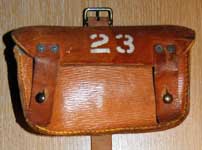
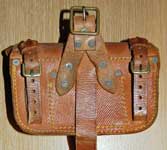 The second Pouch in Rog's pair. This one is maker marked "WS Ltd." and dated 1941.
The second Pouch in Rog's pair. This one is maker marked "WS Ltd." and dated 1941.
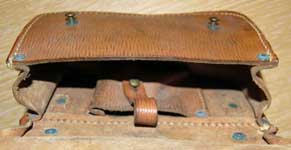 A view of the interior of one Pouch. In the Patt. '14 Pouch, the inside pocket held 10 rounds of .303-inch ammunition in two chargers. It's not clear what function this pocket performed in the Pouch's role as a tool carrier.
A view of the interior of one Pouch. In the Patt. '14 Pouch, the inside pocket held 10 rounds of .303-inch ammunition in two chargers. It's not clear what function this pocket performed in the Pouch's role as a tool carrier.
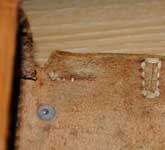
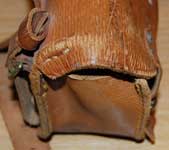 Views of the Pouch lid, showing the technique used to provide weather protection by "hooding" the top. This was a carry-over from the earlier design, but the technique used to accomplish this is different. On the Patt. '14 Pouches we've seen, the dart is a cut, folded inside & stitched. Simple enough, but note the details at left. The cut is vee shaped, the edges then drawn together, where they're butt-stitched - more complex and a more "quality" leather working technique.
Views of the Pouch lid, showing the technique used to provide weather protection by "hooding" the top. This was a carry-over from the earlier design, but the technique used to accomplish this is different. On the Patt. '14 Pouches we've seen, the dart is a cut, folded inside & stitched. Simple enough, but note the details at left. The cut is vee shaped, the edges then drawn together, where they're butt-stitched - more complex and a more "quality" leather working technique.
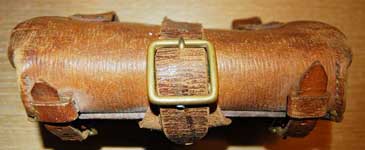 A top view, showing how the centre strap is wrapped around the Pouch to provide secure closure. In the Patt. '14 Pouch, the strap served as an attachment point for equipment hung below the Belt. This change in function explains why the strap was reversed in the later design.
A top view, showing how the centre strap is wrapped around the Pouch to provide secure closure. In the Patt. '14 Pouch, the strap served as an attachment point for equipment hung below the Belt. This change in function explains why the strap was reversed in the later design.

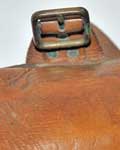 Another small difference between the Lineman pouch and its older sibling. On the Lineman pouch (far left), the tongue on the centre buckle is behind the buckle frame, which is the opposite way round from the buckle on the Patt. '14 Pouch (near left, shown from the front). As with the reversal of the strap, this change is explained by its new role.
Another small difference between the Lineman pouch and its older sibling. On the Lineman pouch (far left), the tongue on the centre buckle is behind the buckle frame, which is the opposite way round from the buckle on the Patt. '14 Pouch (near left, shown from the front). As with the reversal of the strap, this change is explained by its new role.
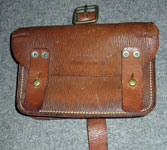
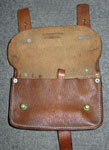
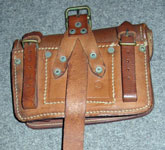 Another, very interesting example, of the Pouch, tool, lineman. Or is it an I.E. Pattern 1914 Pouch, ammunition, 60 rounds, leather, Pattern modified? Dated 1942, is has to be a Lineman pouch, but the strap and buckle are correctly oriented for the Patt. '14 Pouch, not the later version. This example is maker marked "H. CARSON Co LTD OTTAWA" and Canadian marked. This is the only Canadian made example we've seen of either the Lineman pouch or any Pattern 1914 equipment. We can only guess that Carsons were trying to produce the Lineman pouch, but copied their design from a Patt. '14 Pouch. From the Graham Tweeddale Collection, photographs © Graham Tweeddale 2012.
Another, very interesting example, of the Pouch, tool, lineman. Or is it an I.E. Pattern 1914 Pouch, ammunition, 60 rounds, leather, Pattern modified? Dated 1942, is has to be a Lineman pouch, but the strap and buckle are correctly oriented for the Patt. '14 Pouch, not the later version. This example is maker marked "H. CARSON Co LTD OTTAWA" and Canadian marked. This is the only Canadian made example we've seen of either the Lineman pouch or any Pattern 1914 equipment. We can only guess that Carsons were trying to produce the Lineman pouch, but copied their design from a Patt. '14 Pouch. From the Graham Tweeddale Collection, photographs © Graham Tweeddale 2012.
Stores Ref. F2/FA 20066 Pouch, tool, empty, No. 1
Stores Ref. 5140-99-428-9823 Pouch, tool, empty, No. 1
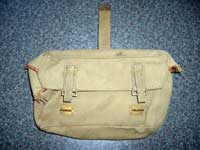

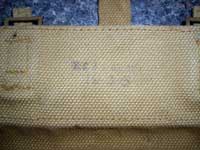 The Patt. ’14 Pouch was large enough to accommodate a pair of Pliers, side-cutting 5-in., but a change to the larger Pliers, linesmen, 8-in. meant these would not fit the old leather pouch. LoC §C2203, approved on 21 February, 1946, therefore made these obsolete and introduced a new pouch in webbing. Whilst “web” was included in the Detail, colour was not and examples made by Bagcraft in 1955 and Remploy in 1964 were dark green, whereas one made by MW&S in 1977 was khaki and NSN coded. The early khaki example shown left, from the Nathan Flavel
Collection, is maker marked "T.B.L. Ltd." and dated 1946.
The Patt. ’14 Pouch was large enough to accommodate a pair of Pliers, side-cutting 5-in., but a change to the larger Pliers, linesmen, 8-in. meant these would not fit the old leather pouch. LoC §C2203, approved on 21 February, 1946, therefore made these obsolete and introduced a new pouch in webbing. Whilst “web” was included in the Detail, colour was not and examples made by Bagcraft in 1955 and Remploy in 1964 were dark green, whereas one made by MW&S in 1977 was khaki and NSN coded. The early khaki example shown left, from the Nathan Flavel
Collection, is maker marked "T.B.L. Ltd." and dated 1946.
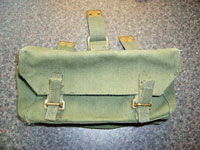

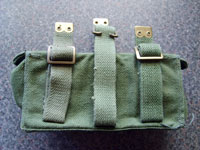 Another example from Nathan's collection. This one is in green web, and is maker marked "Bagcraft Ltd." and dated 1955. All photos this section © Nathan Flavell 2012.
Another example from Nathan's collection. This one is in green web, and is maker marked "Bagcraft Ltd." and dated 1955. All photos this section © Nathan Flavell 2012.
From 1959, field equipment was the dark green Patt. ’58 W.E., so a khaki Pouch seems a perverse reversal. What is rather more interesting, is the straight-line thinking of its design. It might be assumed that a leather Pouch, tool, linesmen was handed to the webbing manufacturers (Mills?), with instructions that a new webbing Pouch was required for longer pliers. As a result, the webbing Pouch is a pointlessly slavish webbing reproduction of the leatherPouch, albeit squared-off and with a box-lid secured by a pair of Quick Release Fasteners. The buckling belt loops were reproduced in 1-inch webbing, as was the central strap, also in 1-inch webbing. Its gated 1-inch buckle shows that the strap was intended to be fastened around the Pouch, just as the leather strap had been, with its corresponding “reversed” tongue buckle and “flesh side outside” strap. No attempt was made to reproduce the 10 round internal pocket though and the Pouch is un-divided inside. The old Belt, waist, Bandolier Equipment was still a stores item and the new Pouch was intended for wear on this old design, albeit the B.E. Belt had continued in production. In C.O.S.A. 1976, it was listed as Belt, waist, brown and incorrectly listed as 1 ¼-inch wide – half an inch short of its true width. It was qualified as with the “…Runner…” (actually a Runner, swivel which referred to the swivel snap hook) that made it into a Belt, lineman.
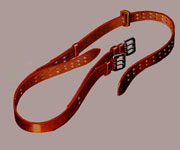 It should be emphasised that this Belt is NOT the Belt, safety, lineman, a Belt of far more sturdy and heavy construction, with double-tongued steel buckles. That Belt is shown left in a painting adapted from British Leather. A Record of Achievement, by H. Pearl Adam, published by Batsford in 1946. It buckled around the lineman’s waist, but had a long extension strap, which was passed around a telegraph pole and secured to a second buckle on a short extension on the right side, allowing him to plant his feet on the metal treads nailed into the pole and lean backwards in safety, to work on the telephone wires. As an aside, both its waist belt component and the safety strap buckled to the right – the ladies’ way!!!
It should be emphasised that this Belt is NOT the Belt, safety, lineman, a Belt of far more sturdy and heavy construction, with double-tongued steel buckles. That Belt is shown left in a painting adapted from British Leather. A Record of Achievement, by H. Pearl Adam, published by Batsford in 1946. It buckled around the lineman’s waist, but had a long extension strap, which was passed around a telegraph pole and secured to a second buckle on a short extension on the right side, allowing him to plant his feet on the metal treads nailed into the pole and lean backwards in safety, to work on the telephone wires. As an aside, both its waist belt component and the safety strap buckled to the right – the ladies’ way!!!